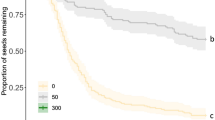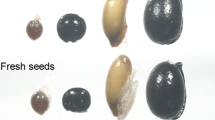Abstract
The scale at which seed dispersal operates has many implications for the spatial patterns of plant recruitment and diversity. We investigated the effect of short- (ants) and long-distance (birds) seed dispersal of the fleshy-fruited melastome, Miconia rubiginosa, in the Brazilian savanna. We estimated the contribution of dispersal vectors to the removal of the fruit crop from the canopy (birds), and once seeds have reached the cerrado floor (ants) over two fruiting seasons. Birds (13 species) removed up to 23.7% of the fruit crop from the crown, but dropped a substantial proportion of fruits beneath the parent plant. Birds removed a greater proportion of fruits from trees producing large fruit crops, as predicted by the fruit crop size hypothesis. However, up to 18.9% of the fruit crop fell beneath the parent plant as ripe fruit. Most fallen fruits were removed by ants (seven genera), which are likely to play a relatively important role in terms of the quantity of seeds dispersed, especially for plants producing small fruit crops (a conceptual model is presented). Birds and ants did not influence seed germination, but they differ in terms of the spatial scale of dispersal and deposition patterns. Ants probably play an important role in the local population dynamics of Miconia, whereas birds are responsible for long-distance dispersal associated with the colonization of new patches and metapopulation dynamics. By removing seeds from bird droppings, ants may also reshape at a finer scale the seed rain generated by primary dispersers. Indeed, seedlings and saplings of Miconia are more frequently found around leaf-cutter ant nests than in control areas away from ant nests or around large Miconia trees. The quantitative component of dispersal effectiveness by ants acting as “rescuers” of seeds that fail to be dispersed, or fall under parent trees, is probably more important than currently recognized in other systems.




Similar content being viewed by others
References
Blendinger PG, Loiselle BA, Blake JG (2008) Crop size, plant aggregation, and microhabitat type affect fruit removal by birds from individual melastome plants in the Upper Amazon. Oecologia 158:273–283
Böhning-Gaese K, Gaese BH, Rabemanantsoa SB (1999) Importance of primary and secondary seed dispersal in the Malagasy tree Commiphora guillaumini. Ecology 80:821–832
Chapman CA, Chapman LJ (1995) Survival without dispersers: seedling recruitment under parents. Conserv Biol 9:675–678
Christian CE, Stanton ML (2004) Cryptic consequences of a dispersal mutualism: seed burial, elaiosome removal, and seed-bank dynamics. Ecology 85:1101–1110
Christianini AV, Mayhé-Nunes AJ, Oliveira PS (2007) The role of ants in the removal of non-myrmecochorous diaspores and seed germination in a Neotropical savanna. J Trop Ecol 23:343–351
Crawley MT (2002) Statistical computing. An introduction to data analysis using S-plus. Wiley, Chichester
Dalling JW, Wirth R (1998) Dispersal of Miconia argentea seeds by the leaf-cutting ant Atta colombica. J Trop Ecol 14:705–710
Dalling JW, Swaine MD, Garwood NC (1998) Dispersal patterns and seed bank dynamics of pioneer trees in moist tropical forest. Ecology 79:564–578
Davidar P, Morton ES (1986) The relationship between fruit crop sizes and fruit removal rates by birds. Ecology 67:262–265
Farji-Brener AG, Ghermandi L (2004) Seedling recruitment in a semi-arid Patagonian steppe: facilitative effects of refuse dumps of leaf-cutting ants. J Veg Sci 15:823–830
Farji-Brener AG, Illes AE (2000) Do leaf-cutting ant nests make “bottom-up” gaps in neotropical rain forests? A critical review of the evidence. Ecol Lett 3:219–227
Farji-Brener AG, Medina CA (2000) The importance of where to dump the refuse: seed bank and fine roots in nests of the leaf-cutting ants Atta cephalotes and Atta colombica. Biotropica 32:120–126
Farji-Brener AG, Silva JF (1996) Leaf cutter ants (Atta laevigata) aid to establishment success of Tapirira velutinifolia (Anacardiaceae) seedlings in a parkland savanna. J Trop Ecol 12:163–168
Fragoso JMV (1997) Tapir-generated seed shadows: scale-dependent patchiness in the Amazon rain forest. J Ecol 85:519–529
Fragoso JMV, Silvius KM, Correa JA (2003) Long-distance seed dispersal by tapirs increases seed survival and aggregates tropical trees. Ecology 84:1998–2006
García D, Zamora R, Gómez JM, Hódar JA (2001) Frugivory at Juniperus communis depends more on population characteristics than on individual attributes. J Ecol 89:639–647
García D, Rodríguez-Cabal MA, Amico GC (2009) Seed dispersal by a frugivorous marsupial shapes the spatial scale of a mistletoe population. J Ecol 97:217–229
Giannotti E (1988) Composição florística e estrutura fitossociológica da vegetação de cerrado e da transição entre cerrado e mata ciliar da Estação Experimental de Itirapina (SP). Master’s thesis, Universidade Estadual de Campinas, Campinas
Godínez-Alvarez H, Valiente-Banuet A, Rojas-Martínez A (2002) The role of seed dispersers in the population dynamics of the columnar cactus Neobuxbaumia tetetzo. Ecology 83:2617–2629
Green DS (1983) The efficacy of dispersal in relation to safe site density. Oecologia 56:356–358
Harms KE, Wright SJ, Calderón O, Hernández A, Herre EA (2000) Pervasive density-dependent recruitment enhances seedling diversity in a tropical forest. Nature 404:493–495
Hoffmann WA (1996) The effects of fire and cover on seedling establishment in a Neotropical savanna. J Ecol 84:383–393
Horvitz CC, Le Corff J (1993) Spatial scale and dispersion pattern of ant- and bird-dispersed herbs in two tropical lowland rain forests. Vegetatio 107(108):351–362
Howe HF (1980) Monkey dispersal and waste of a Neotropical fruit. Ecology 61:944–959
Howe HF (1989) Scatter- and clump-dispersal and seedling demography: hypothesis and implications. Oecologia 79:417–426
Howe HF, Estabrook GF (1977) On intraspecific competition for avian dispersers in tropical trees. Am Nat 111:817–832
Hubbell SP, Foster RB, Harms KE, O’brien ST, Condit R, Wechsler B, Wright SJ, Loo de Lao S (1999) Light-gap disturbances, recruitment limitation, and tree diversity in a Neotropical forest. Science 283:554–557
Jordano P (1995) Frugivore-mediated selection on fruit and seed size: birds and St. Lucie’s cherry, Prunus mahaleb. Ecology 76:2627–2639
Jordano P, Schupp EW (2000) Seed disperser effectiveness: the quantity component and patterns of seed rain for Prunus mahaleb. Ecol Monogr 70:591–615
Jordano P, Garcia C, Godoy JA, Garcia-Castaño JL (2007) Differential contribution of frugivores to complex seed dispersal patterns. Proc Natl Acad Sci USA 104:3278–3282
Kalisz S, Hanzawa FM, Tonsor SJ, Thiede DA, Voigt S (1999) Ant-mediated seed dispersal alters pattern of relatedness in a population of Trillium grandiflorum. Ecology 80:2620–2634
Kaspari M (1993) Removal of seeds from Neotropical frugivore feces: ant responses to seed number. Oecologia 95:81–88
Leal IR, Oliveira PS (1998) Interactions between fungus–growing ants (Attini), fruits and seeds in cerrado vegetation in southeast Brazil. Biotropica 30:170–178
Levey DJ, Byrne MM (1993) Complex ant–plant interactions: rain forest ants as secondary dispersers and post-dispersal seed predators. Ecology 74:1802–1812
Loiselle BA, Blake JG (1999) Dispersal of melastome seeds by fruit-eating birds of tropical forest understory. Ecology 80:330–336
Mckey D (1975) The ecology of coevolving seed dispersal systems. In: Gilbert LE, Raven P (eds) Coevolution of animals and plants. University of Texas Press, Austin, pp 159–191
Murray KG (1988) Avian seed dispersal of three Neotropical gap-dependent plants. Ecol Monogr 58:271–298
Nathan R, Muller-Landau HC (2000) Spatial patterns of seed dispersal, their determinants and consequences for recruitment. Trends Ecol Evol 15:278–285
Oliveira PS, Galetti M, Pedroni F, Morellato LPC (1995) Seed cleaning by Mycocepurus goeldii ants (Attini) facilitates germination in Hymenaea courbaril (Caesalpiniaceae). Biotropica 27:518–522
Oliveira-Filho AT, Ratter JA (2002) Vegetation physiognomies and woody flora of the cerrado biome. In: Oliveira PS, Marquis RJ (eds) The cerrados of Brazil: ecology and natural history of a Neotropical savanna. Columbia University Press, New York, pp 91–120
Ortíz-Pulido R, Rico-Gray V (2000) The effect of spatio-temporal variation in understanding the fruit crop size hypothesis. Oikos 91:523–527
Passos L, Oliveira PS (2002) Ants affect the distribution and performance of seedlings of Clusia criuva, a primarily bird-dispersed rain forest tree. J Ecol 90:517–528
Passos L, Oliveira PS (2003) Interactions between ants, fruits and seeds in a restinga forest in south-eastern Brazil. J Trop Ecol 19:261–270
Passos L, Oliveira PS (2004) Interaction between ants and fruits of Guapira opposita (Nyctaginaceae) in a Brazilian sandy plain rainforest: ant effects on seeds and seedlings. Oecologia 139:376–382
Pizo MA, Oliveira PS (1999) Removal of seeds from vertebrate faeces by ants: effects of seed species and deposition site. Can J Zool 77:1595–1602
Pizo MA, Oliveira PS (2000) The use of fruits and seeds by ants in the Atlantic forest of southeast Brazil. Biotropica 32:851–861
Pizo MA, Oliveira PS (2001) Size and lipid content of nonmyrmecochorous diaspores: effects on the interaction with litter-foraging ants in the Atlantic rain forest of Brazil. Plant Ecol 157:37–52
Retana J, Picó FX, Rodrigo A (2004) Dual role of harvesting ants as seed predators and dispersers of a non-myrmechorous Mediterranean perennial herb. Oikos 105:377–385
Rico-Gray V, Oliveira PS (2007) The ecology and evolution of ant–plant interactions. The University of Chicago Press, Chicago
Roberts JT, Heithaus R (1986) Ants rearrange the vertebrate-generated seed shadow of a Neotropical fig tree. Ecology 67:1046–1051
Sallabanks R (1993) Hierarchical mechanisms of fruit selection by an avian frugivore. Ecology 74:1326–1336
Schupp EW (1988) Factors affecting post-dispersal seed survival in a tropical forest. Oecologia 76:525–530
Schupp EW (1993) Quantity, quality, and effectiveness of seed dispersal by animals. Vegetatio 107(108):15–29
Snow DW (1971) Evolutionary aspects of fruit-eating by birds. Ibis 113:194–202
Spiegel O, Nathan R (2007) Incorporating dispersal distance into the disperser effectiveness framework: frugivorous birds provide complementary dispersal to plants in a patchy environment. Ecol Lett 10:718–728
Vander Wall SB, Longland WS (2004) Diplochory: are two seed dispersers better than one? Trends Ecol Evol 19:297–314
Wirth R, Herz H, Ryel RJ, Beyschlag W, Hölldobler B (2003) Herbivory of leaf-cutting ants: a case study of Atta colombica in the tropical rainforest of Panama. Springer, Berlin
Wright SJ, Zeballos H, Dominguez I, Gallardo MM, Moreno MC, Ibanez R (2000) Poachers alter mammal abundance, seed dispersal, and seed predation in a Neotropical forest. Conserv Biol 14:227–239
Acknowledgments
This study was supported by FAPESP (proc. 02/12895-8), and the Wisconsin Society of Science Teachers, and is part of the Ph.D. dissertation of A. V. C. at the Programa de Pós-Graduação em Ecologia da Universidade Estadual de Campinas. We benefited from criticisms by A. G. Farji-Brener and C. M. Herrera (who called our attention to the role of ants as seed rescuers). We thank A. J. Mayhé-Nunes for ant identification, J. Y. Tamashiro for plant identification, C. Haddad for permission to use the germination chamber of the Departamento de Fisiologia Vegetal, H. C. Menezes for the chemical analyses of the fruits, and L. E. Lopes for help with the statistical analyses. We thank the Instituto Florestal de São Paulo for allowing us to work in its cerrado reserve. C. Cestari, M. M. Martins, and P. Rubim helped during fieldwork. P. S. O. was supported by research grants from the CNPq (proc. 304521/2006-0), and FAPESP (proc. 08/54058-1). The experiments presented in this study comply with the current laws of Brazil.
Author information
Authors and Affiliations
Corresponding author
Additional information
Communicated by Diethart Matthies.
Electronic supplementary material
This file is unfortunately not in the Publisher's archive anymore: Supplementary material 1 (TTF 81 kb)
Rights and permissions
About this article
Cite this article
Christianini, A.V., Oliveira, P.S. The relevance of ants as seed rescuers of a primarily bird-dispersed tree in the Neotropical cerrado savanna. Oecologia 160, 735–745 (2009). https://doi.org/10.1007/s00442-009-1349-2
Received:
Accepted:
Published:
Issue Date:
DOI: https://doi.org/10.1007/s00442-009-1349-2




